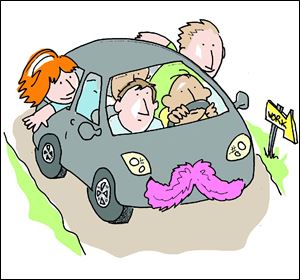
Carpooling is picking up; Lyft Line app offers riders big discounts
8/9/2014
Every weekday, about three-quarters of the nation’s adult workers — more than 100 million people — drive to work alone. It was ever thus: Americans, it seems, just don’t like to travel together.
John Zimmer and Logan Green, the founders of the ride service Lyft, say they want to change that.
Lyft, like its better-known rival Uber, lets you call a car using a smartphone app, and a driver who is also using the app rushes to pick you up. This past week, beginning in San Francisco, Lyft introduced a new feature, Lyft Line, that instantly matches riders who are traveling between similar places at similar times, and offers each of them a deep discount to share a ride rather than go solo.
The plan is a clever way for a car-sharing app to go beyond reducing our dependence on private car ownership — with carpooling, it could end up reducing the number of cars on the road.
The discounts offered by Lyft Line range from 10 to 60 percent off a standard ride; on average, the company expects people to save up to 40 percent for sharing. These discounts would mean traveling from San Francisco’s popular Mission neighborhood to the Financial District for about $5 a ride; using standard Lyft, Uber, or a taxi, that ride might cost $9 or more.
Even better, unlike Uber and Lyft’s regular service, Lyft Line will show you a guaranteed price before you book the car, rather than after your ride.
At these prices, Lyft Line could become one of the cheapest ways to travel between many parts of the city — so cheap that people might use it to go to and from work daily, instead of driving alone.
Though the service will be available in San Francisco at first, Lyft has run simulations of Line using its data from other regions, and it believes the service will work well in many suburbs and cities across the nation. It plans to begin rolling out Lyft Line elsewhere within a few months.
The firm’s high hopes for Lyft Line haven’t met the real world, where any number of fiascos could intervene.
For one, there is likely to be competition. Lyft’s archrival, Uber, announced Tuesday that it was testing a similar service, UberPool, at first available to a limited number of users on an invitation-only basis. Uber gave few details about what its service would look like, saying only that its carpooling could save riders 40 percent.
It is worth remembering that sharing has never been particularly popular in America; according to the Census Bureau, carpooling hit a recent peak in the 1970s, when about 20 percent of Americans commuted to work by car pool. By 2008, just over 10 percent did.
Lyft is betting it can use economic incentives to change attitudes. It expects people to still use its standard, single-rider service when they’re in a hurry, but Lyft’s founders say Lyft Line is the future of their ambitions.
A persistent criticism of ride-sharing apps is they don’t reduce the number of cars on the road. When you call a Lyft or Uber ride, you are simply replacing your car with one driven by a paid driver. Mr. Zimmer and Mr. Green say they are vexed by this criticism, because encouraging carpooling has always been one of their goals.
What’s more, Lyft has cultivated a casual identity that may be better suited to car-sharing than the more upscale Uber. Lyft cars display a pink mustache on the grille, and when you get in, you’re supposed to sit in the front seat, not the back. The driver greets you with a fist bump, an implicit invitation to chat, and sometimes goodies.
In a live demo last week, Lyft Line worked elegantly. To start a shared ride, you load up the Lyft app, select the Line service and type in a destination. The system analyzes Lyft’s ridership data to calculate the odds that another rider is heading the same way; the higher the odds, the greater the discount.
If you accept Lyft’s price, a car is sent to get you. While the car heads out, the app seeks other people heading your way. It matches only people whose routes won’t take you more than five minutes out of your way. If Lyft finds someone to ride with you, the driver picks you up, then the other person, and then drops each of you off.
Sometimes the app won’t find someone to ride with you, in which case you luck out — you ride solo, but get the discounted price anyway.